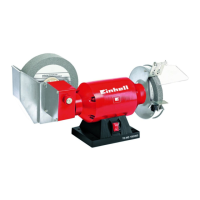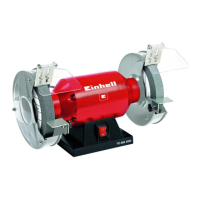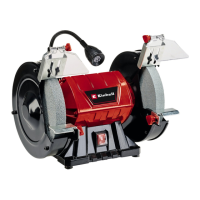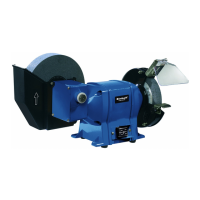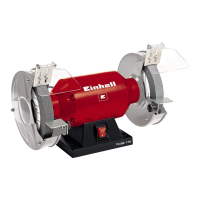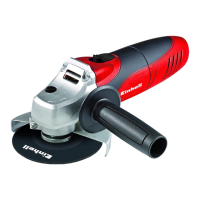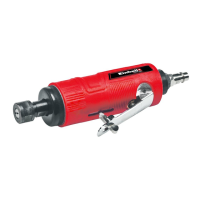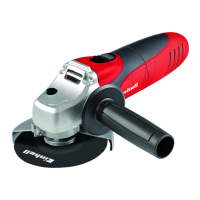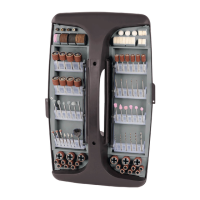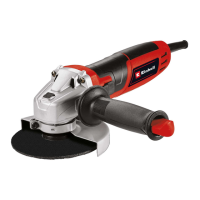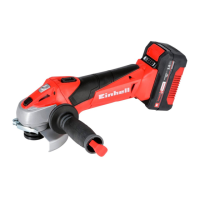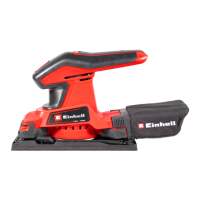GB
- 20 -
Caution!
Residual risks
Even if you use this electric power tool in
accordance with instructions, certain resi-
dual risks cannot be rules out. The following
hazards may arise in connection with the
equipment’s construction and layout:
1. Lung damage if no suitable protective dust
mask is used.
2. Damage to hearing if no suitable ear protec-
tion is used.
3. Health damage caused by hand-arm vib-
rations if the equipment is used over a pro-
longed period or is not properly guided and
maintained.
5. Before starting the equipment
Before you connect the equipment to the mains
supply make sure that the data on the rating plate
are identical to the mains data.
Warning!
Always pull the power plug before making
adjustments to the equipment.
Pull the power plug before doing any mainte-
nance or assembly work on the equipment.
•
The equipment has to be set up where it can
stand securely.
•
Before starting work, firmly screw the grin-
ding/sanding machine to the workbench or
equivalent using the 4 mounting holes (8) in
the base plate (9).
•
All covers and safety devices have to be pro-
perly fitted before the equipment is switched
on.
•
It must be possible for the grinding wheel and
the honing wheel to run freely.
•
Check that the voltage on the rating plate is
the same as your supply voltage before you
connect the equipment to the power supply.
5.1 Fitting the water container (Fig. 2a/3)
•
To fit the water container (10), latch the hooks
(14) into the lower mounting eyelets (12).
•
Important! It is not necessary to remove the
wet grinding wheel (5) to do this.
•
Important! If the diameter of the wet grinding
wheel (5) has become worn down so much
that the wet grinding wheel no longer touches
the water, fit the water container (10) to the
upper mounting eyelets (13).
•
Fill the water container (10) with water up to
approx. 5 mm below the overflow (11).
•
Important! When the equipment is used for
the first time or after a long period of non-use,
the wet grinding wheel will soak up water.
Switch on the machine so that the wheel
turns and can soak up water at the same time.
Slowly fill the water container (10) until the
water level stays constant.
Warning!
Empty the water container (10) each time after
use. The part of the wet grinding wheel (5) which
is submerged in the water would otherwise soak
up water unevenly. Grinding wheel imbalance
must be avoided.
5.2 Fitting the clamping device (Fig. 1/2b/4)
•
The support arm (24) which is supplied with
the equipment can be fastened in two posi-
tions.
•
Depending on the sharpening angle and tool
size you can fit the support arm (24) in either
the horizontal mounting hole (28) or the verti-
cal mounting hole (26).
•
To adjust the distance between the support
arm (24) and the wet grinding wheel (5), turn
the knurled nut (25) until the required dis-
tance is reached.
•
Fasten the support (24) with the two locking
screws (27).
•
Slide the clamping device (2) onto the sup-
port arm (24) so that the clamping plate (3) is
positioned above the middle of the wet grin-
ding wheel (5) (see Fig. 1).
5.3 Adjusting the sharpening angle on the
angle gauge (Fig. 2c)
•
Before you can adjust the sharpening angle
on the wet grinder, you first have to determine
the existing sharpening angle of your tool bla-
de.
•
You can use the notches (22) on the angle
gauge (17) to do this. Hold the blade of your
tool in the notches (22). Read off the angle on
the appropriate notch (22).
•
In the second step, adjust the angle gauge to
the wheel diameter of the wet grinder.
•
Move the pointer on the scale (19) to the va-
lue for the diameter of the wet grinding wheel
(see technical data) and secure it with the
knurled screw (18).
•
Important! If the wet grinding wheel (5) gets
worn, you need to readjust the wheel diame-
Anl_TC-WG_200_SPK9.indb 20 07.09.2020 14:38:51
